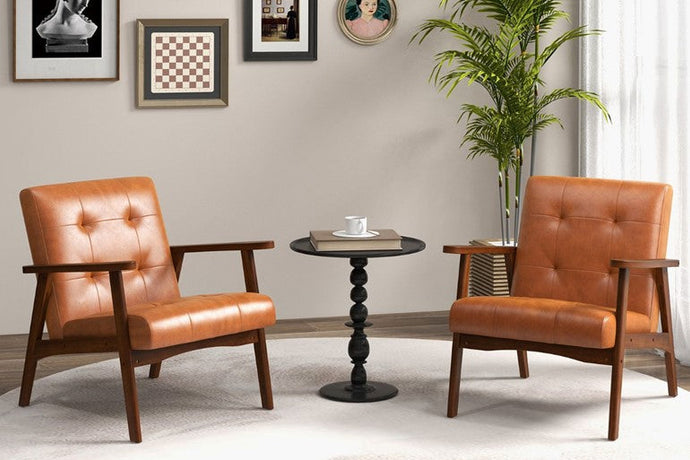- No products in the cart.
MIXING AND MATCHING: HOW TO PAIR ACCENT CHAIRS WITH SOFAS
08
Jul
In the world of interior design, accent chairs are more than just extra seating—they’re statement pieces that add depth, contrast, and personality to your living space. When paired thoughtfully with a sofa, these chairs can elevate a room from ordinary to outstanding. Whether you're aiming for harmony or bold contrast, mastering the art of mixing and matching accent chairs with sofas is key to a well-styled home. This blog post will guide you through everything you need to know about coordinating your accent chairs with your sofa for a balanced and beautiful space.
What Are Accent Chairs and Why Are They Essential?
Accent chairs are standalone seating pieces designed to complement the aesthetic of a room. Unlike sofas, which are often larger and more neutral, accent chairs are meant to stand out—either through their shape, colour, fabric, or design.
Key reasons accent chairs matter:
-
Add visual interest
-
Introduce new textures and colours
-
Create functional seating zones
-
Help tie together disparate design elements
The Art of Balance: Pairing Accent Chairs with Sofas
When mixing accent chairs with sofas, balance is everything. You want a look that’s intentional, not chaotic. A mismatched but well-thought-out combo often looks more stylish than a perfectly matched set.
Key principles of balance:
-
Scale and proportion: Keep seating pieces within a similar size range.
-
Visual weight: Consider how heavy or light a piece looks based on its frame and upholstery.
-
Spatial flow: Leave enough room between pieces to maintain easy movement.
Matching Colours: Playing with Palettes
Colour coordination is a powerful tool when it comes to matching accent chairs with your sofa.
Three effective colour strategies:
-
Monochromatic: Use different shades of the same colour for a subtle, cohesive look. Example: a navy sofa with light blue chairs.
-
Analogous: Combine neighbouring colours on the colour wheel, like a forest green sofa with teal or mustard accent chairs.
-
Complementary: Choose opposing colours for contrast—such as a grey sofa with burnt orange chairs—for a vibrant and dynamic appearance.
Bonus tip: Use throw pillows, rugs, or artwork to echo accent chair colours for visual consistency.
Mixing Textures and Fabrics
Texture adds dimension to a room. Combining materials—like a leather sofa with a velvet or boucle accent chair—can make your space feel layered and curated.
Popular texture pairings:
-
Leather and linen
-
Velvet and wood
-
Bouclé and suede
-
Cotton and rattan
Aim to include at least three textures in your living area for a well-rounded design scheme.
Patterns and Prints: How Bold Should You Go?
Accent chairs are a great opportunity to play with patterns. But it’s important to avoid clashing prints.
Tips for mixing patterns:
-
Pair a solid-colour sofa with a patterned chair.
-
Stick to a unified colour palette even when using different prints.
-
Mix scale: large-scale patterns on the sofa, smaller prints on the accent chair (or vice versa).
Florals, stripes, geometrics, and tribal prints all work well—just ensure they complement your overall theme.
Shape and Style: Blending the Old with the New
Different furniture styles can coexist beautifully when handled with care.
Consider mixing:
-
A sleek mid-century modern sofa with a curved, contemporary accent chair
-
A traditional tufted sofa with minimalist Scandinavian seating
-
A farmhouse-style couch with industrial-style metal-frame accent chairs
The contrast can be striking and modern—as long as there's a unifying design element, such as shared wood tones or coordinating colours.
Size and Scale: Getting Proportions Right
Pairing a large, bulky sofa with tiny accent chairs can feel visually jarring. Likewise, oversized chairs next to a slimline sofa can throw off the room’s equilibrium.
General rules:
-
Accent chairs should be within 6–8 inches of the sofa seat height
-
Backrests should not tower far above the sofa’s back
-
Choose chairs that visually “balance” the sofa in size and stature
If your sofa has arms, consider whether your accent chair should also have arms for balance—or go armless for contrast.
Creating Conversation Zones
Accent chairs aren’t just for style—they also improve functionality.
Design tips for seating arrangement:
-
Angle chairs slightly toward the sofa to promote interaction
-
Use a coffee table or area rug to define the seating zone
-
Place chairs in pairs if you have the space, especially in open-plan rooms
This arrangement creates a cosy and welcoming vibe, perfect for entertaining or family time.
How Many Accent Chairs Should You Use?
The number of accent chairs depends on the size and layout of your room.
-
Small rooms: One chair may be sufficient
-
Medium-sized rooms: Two matching or complementary chairs work well
-
Large open spaces: Consider a pair plus a third for symmetry and flow
Make sure the room doesn’t feel overcrowded. Negative space is crucial for keeping the layout breathable and functional.
Playing with Positioning: Where to Place Accent Chairs
Placement is just as important as selection.
Top placement ideas:
-
Opposite the sofa to create a balanced layout
-
Diagonally next to the sofa for an angled conversation nook
-
Near a window with a side table for a reading corner
-
Flanking a fireplace or media console
Avoid placing chairs too far from the main seating area unless you're intentionally creating a separate zone.
Pairing by Design Style
Here’s how to mix and match accent chairs based on different interior design styles:
Modern:
-
Look for clean lines, minimal upholstery, and bold colours
-
Pair with geometric or glass elements
Scandinavian:
-
Natural wood frames, soft textures, and neutral tones
-
Light grey sofas with beige or cream chairs work beautifully
Traditional:
-
Classic wingback chairs or tufted designs
-
Match with rolled-arm sofas in complementary fabrics
Bohemian:
-
Mix rattan or woven chairs with eclectic fabric patterns
-
Earthy tones and layered textiles enhance the look
Industrial:
-
Choose metal-framed chairs with leather or canvas upholstery
-
Pair with distressed leather sofas and exposed brick accents
Accents and Accessories to Tie It All Together
Using accessories is key to unifying different elements in the room.
Helpful accents include:
-
Cushions that match the chair’s fabric or colour
-
Throws that drape over both the sofa and chair
-
Art pieces that contain all the room’s core colours
-
Lamps and side tables that complement both items
This method creates cohesion, even if your chair and sofa are visually different.














